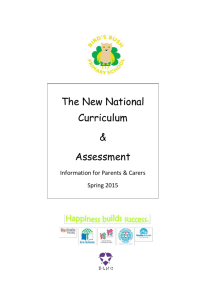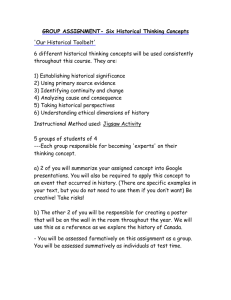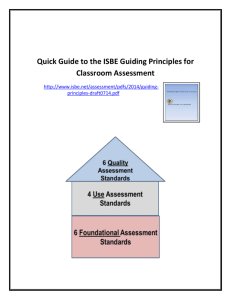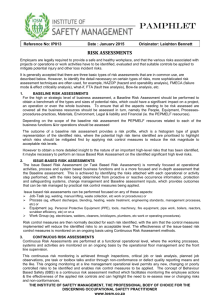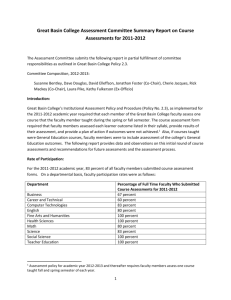NCCRESt Rubric Template for Work Session
advertisement
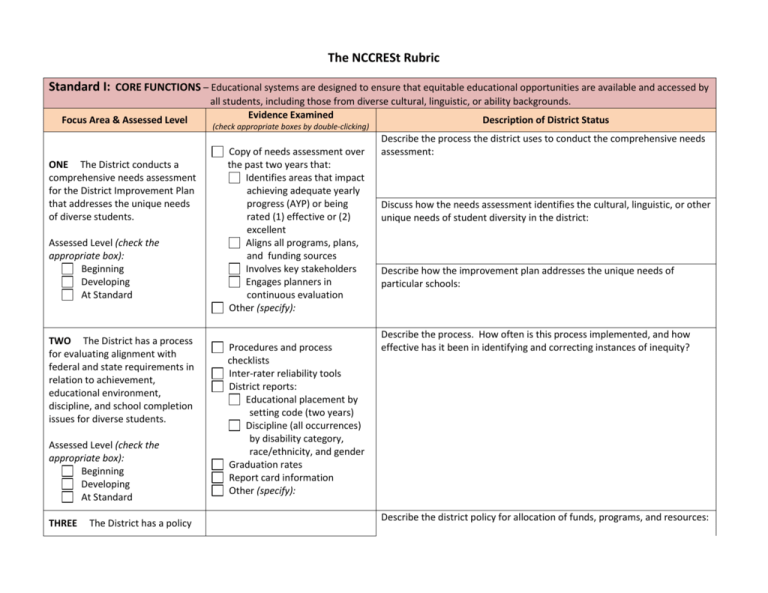
The NCCRESt Rubric Standard I: CORE FUNCTIONS – Educational systems are designed to ensure that equitable educational opportunities are available and accessed by Focus Area & Assessed Level ONE The District conducts a comprehensive needs assessment for the District Improvement Plan that addresses the unique needs of diverse students. Assessed Level (check the appropriate box): Beginning Developing At Standard TWO The District has a process for evaluating alignment with federal and state requirements in relation to achievement, educational environment, discipline, and school completion issues for diverse students. Assessed Level (check the appropriate box): Beginning Developing At Standard THREE The District has a policy all students, including those from diverse cultural, linguistic, or ability backgrounds. Evidence Examined Description of District Status (check appropriate boxes by double-clicking) Copy of needs assessment over the past two years that: Identifies areas that impact achieving adequate yearly progress (AYP) or being rated (1) effective or (2) excellent Aligns all programs, plans, and funding sources Involves key stakeholders Engages planners in continuous evaluation Other (specify): Procedures and process checklists Inter-rater reliability tools District reports: Educational placement by setting code (two years) Discipline (all occurrences) by disability category, race/ethnicity, and gender Graduation rates Report card information Other (specify): Describe the process the district uses to conduct the comprehensive needs assessment: Discuss how the needs assessment identifies the cultural, linguistic, or other unique needs of student diversity in the district: Describe how the improvement plan addresses the unique needs of particular schools: Describe the process. How often is this process implemented, and how effective has it been in identifying and correcting instances of inequity? Describe the district policy for allocation of funds, programs, and resources: that ensures that monetary, physical, and other resources, including qualified personnel, are distributed to schools according to need. This includes ensuring that all schools have comparable physical facilities in terms of safety and optimal learning environments. District and school level budgets Policy for teacher assignments Policy for resource allocation Policy related to incentives Other (specify): How are teachers and administrators assigned to schools? What incentives exist to encourage the best teachers to work in schools with the highest need? Assessed Level (check the appropriate box): Beginning Developing At Standard FOUR The District has a process for continuous improvement of student results based on the use of accurate, in-time student outcome data to examine access, participation, and success in the standards-based curriculum. Assessed Level (check the appropriate box): Beginning Developing At Standard Educational placement by setting code (two years) Performance results on statewide measures disaggregated by race, gender, educational setting, and disability setting, including: Classroom observations Benchmark assessments Classroom assessments Classroom work Other (specify): Procedure for selecting and administering assessments in the language and form most likely to yield accurate information on what the child knows and can do academically, developmentally, and functionally Describe the procedure for determining student progress in the general education curriculum: Describe steps taken when students, including those with disabilities, show no or limited progress in the general education curriculum: Assessments used to gather relevant functional, developmental, and academic information Other (specify): FIVE The District identifies and utilizes multiple approaches to supporting student engagement and academic success. Assessed Level (check the appropriate box): Beginning Developing At Standard SIX The District utilizes multiple, culturally responsive methods and strategies to reduce risk factors associated with dropping out of school. Assessed Level (check the appropriate box): Beginning Developing At Standard Report of efforts of the district to identify local risk factors associated with lack of engagement and academic success (i.e. – reports to the board/community, committees, and principal-led activities) Student, family, and community input in the form of engagement measures, satisfaction surveys, or other efforts at collecting information from students, families, and communities Other (specify): Report of efforts of the district to identify local risk factors associated with lack of engagement and academic success (i.e. – reports to the board/community, committees, and principal-led activities) Review of disaggregated data for those students who dropped out of school in the past two years, including: Attendance rates Discipline records Academic performance Describe strategies and programs used to support engagement and academic success: How are students, families, and communities engaged in conversations about school? How are the needs of diverse students incorporated into the district’s understanding of what engagement and success look like? Describe methods and strategies used by the district to reduce risk factors associated with dropping out of school, including poor attendance, academic achievement, and behavioral incidents: Other (specify): Other (specify): SEVEN The District engages in in-depth efforts to help teachers and administrators understand the ways in which race, ethnicity, culture, social class, ability, and language influence learning and achievement for all students. Assessed Level (check the appropriate box): Beginning Developing At Standard Compliance checklists Performance on statewide/ district-wide assessments (disaggregated by race, gender, and disability category) Classroom-based measures (data disaggregated by race, gender, and disability category) Professional development opportunities (i.e. – recognizing language and communication differences, cultural awareness, culturally responsive educators addressing diversity) Other (specify): Describe how the district helps teachers and administrators understand the ways in which race, culture, social class, ability, and language influence learning and achievement for all students: Standard II: INSTRUCTIONAL SERVICES – Learning environments at all grade levels are designed to support and produce academic achievement Focus Area & Assessed Level EIGHT The District’s curriculum is aligned with state content standards and benchmarks, and is research-based and comprehensive so that it meets for diverse learners. Evidence Examined (check appropriate boxes by double-clicking) Evidence of locally-developed curriculum (board minutes or board/district policies) Evidence of support for the Description of District Status Describe the district’s process for creating, adopting, and implementing curricula: the needs of diverse learners. Assessed Level (check the appropriate box): Beginning Developing At Standard NINE The District ensures that all school personnel understand ways in which communication patterns can influence engagement in learning and achievement for students who are culturally or linguistically diverse. Assessed Level (check the appropriate box): Beginning Developing At Standard review, revision, and implementation of the curriculum (i.e. – meetings, staff job descriptions with roles and responsibilities) Evidence of supplemental resources, to accompany the curriculum, that address culturally responsive needs and practices Evidence of professional development that infuses cultural responsiveness throughout workshops and other forms of development Other (specify): How are curricula aligned with state content standards? What components of the curriculum accommodate cultural and linguistic issues within the community? How does the curriculum increase the likelihood of improved performance for culturally and linguistically diverse populations? Describe the district’s efforts to ensure that school personnel understand Lesson plan format/content and utilize information related to communication patterns: Efforts to address language differences at the school-wide level and the targeted (group) level Efforts to analyze the language requirements of: Curriculum materials Classroom-based assessments How do school personnel differentiate and accommodate in order to meet Large-scale assessments the needs of culturally or linguistically diverse learners? List of professional development made available with follow-up (i.e. – meeting agendas, list of participants, etc.) Topics such as: Differentiated Instruction and Communication Strategies Other (specify): TEN The District ensures that school policies and rules consider the cultural and linguistic characteristics of its students. Assessed Level (check the appropriate box): Beginning Developing At Standard ELEVEN The District identifies and accesses community resources to address the needs of culturally and linguistically diverse students. Assessed Level (check the appropriate box): Beginning Developing At Standard TWELVE The District ensures that students who are culturally and linguistically diverse are represented equitably in all programs, including those for Building/district policies & rules Structure and process for reviewing & revising policies/rules Analysis of infractions disaggregated by disability, race, and gender Analysis of discipline data by point of referral, place of occurrence, and categories of people who identify discipline problems Process for disseminating and teaching rules Other (specify): Describe how the district involves students, families, and communities in the development of policies/rules: How are these rules/policies articulated to ensure they are understood and embedded in student social and behavioral repertoire? Describe how the district identifies and accesses community resources: List of community resources with frequency of contact during the past year Process for generating the list of community resources, revising the list, and disseminating the list to district staff. Other (specify): How does the district identify and rectify gaps in available resources? What resources are available, which resources have been utilized by the team, and how have they been utilized? Describe the range of programs available in the district: Program options and participation/enrollment rates within the district (including cocurricular and extra-curricular) gifted and rapidly progressing students. Assessed Level (check the appropriate box): Beginning Developing At Standard THIRTEEN The District provides and requires that effective intervention options be used to respond to student learning difficulties before (or in lieu of) referral for special education services. Assessed Level (check the appropriate box): Beginning Developing At Standard FOURTEEN The District provides ongoing training and support to ensure that teachers address individual learning needs through differentiated instruction aligned to academic grade-level content. Assessed Level (check the appropriate box): Beginning Developing At Standard Disaggregated participation rates by race, gender, and disability category Level of staffing and the qualifications of the staff Other (specify): Lists of intervention options utilized at each level, including: School wide (primary) Targeted (secondary) Intensive (tertiary) Evidence of the impact of the interventions on academic and behavioral performance (i.e. – improved results for those participating in the intervention) Other (specify): Curriculum mapping Assessment mapping LRE (least restrictive environment) analysis over the past three years (where are students with disabilities receiving services?) Accommodations provided to students (identified on the IEP) Performance rates – compared to educational setting Other (specify): Are there programs in which culturally and linguistically diverse students are over- or under-represented? If so, what steps are taken to reduce/eliminate obstacles to ensure balanced representations in programs? Describe what types of intervention options are available within the district to respond to learning difficulties before (or in lieu of) referral for special education services: Describe the types of intervention that the district can use to reduce the likelihood that students will experience learning difficulties: What evidence is available to indicate that these intervention options have been effective? How does the district ensure that academic and behavioral interventions are planned and implemented in ways that are culturally and linguistically responsive? Describe the professional development and support provided by the district: How have these efforts increased access to the general curriculum for all students? FIFTEEN The District provides ongoing information and training to educate families about individual learning needs, grade level standards, achievement, and learning support processes, including special education. Assessed Level (check the appropriate box): Beginning Developing At Standard District materials that include information about individual learning needs, grade level standards, achievement, and the referral process for families Evidence that the district solicits and values input from all families Other (specify): Describe how the district provides information to families, how outreach is provided to ensure families have access to and involvement in the development of information and training resources: Standard III: INDIVIDUALIZED EDUCATION – Children with disabilities are ensured access to, participation in, and progress in the general Focus Area & Assessed Level SIXTEEN District procedures for location, referral, and identification are transparent, equitable, and multi-disciplinary. Assessed Level (check the appropriate box): Beginning Developing At Standard curriculum. Evidence Examined (check appropriate boxes by double-clicking) Classroom observations Benchmark assessments Classroom assessments Classroom work District procedures for selecting and administering assessments in the language and form most likely to yield accurate information on what the child knows and can do academically, developmentally, and functionally Assessments used to gather relevant: Description of District Status Describe the procedures that the district has in place for locating, referring, and identifying students ages 3 through 21: Functional Information (specify): Developmental Information (specify): Academic Information (specify): Other (specify): SEVENTEEN The District regularly reviews referral and eligibility decisions for special education, including methods, types of measures, and frequency with which identification decisions are made. Assessed Level (check the appropriate box): Beginning Developing At Standard EIGHTEEN The District evaluates the progress of students receiving special education services, Data regarding the number of referrals, identifications, and reviews Process for reviewing eligibility determinations Procedure for selecting and administering assessments in the language and form most likely to yield accurate information on what the child knows and can do academically, developmentally, and functionally Assessments used to gather relevant functional, developmental, and academic information Other (specify): Performance of students with disabilities on statewide Describe the methods, types of measures, and frequency with which the district reviews referral and eligibility for special education: Describe the types of tests and instruments used to conduct individual assessments when a student is referred for special education: How are these instruments chosen, and what does the district do to minimize bias for culturally and linguistically diverse students? Describe the methods and types of measures the district uses to evaluate the progress of students receiving special education services (e.g. at the IEP level, academic standards, etc.): including methods and types of measures, as a part of its continuous improvement processes. Assessed Level (check the appropriate box): Beginning Developing At Standard assessments by: Disability category Race/ethnicity Gender Grade retention for students with disabilities Data collection related to the percent of students who meet IEP standards within one academic year Review of IEP standards Progress reports Curriculum-based assessments Benchmarks Short-cycle assessments (such as diagnostic screening) District procedures for analyzing assessments District supports for interpreting assessments Other (specify): How are the results used to improve instruction and services? Describe the method the district uses to analyze LRE data for each school: NINETEEN The District ensures that all students are educated in the least restrictive environment (LRE). Assessed Level (check the appropriate box): Beginning Developing At Standard Compliance checklists Inter-rater reliability tools Data reports, including: Educational placement by setting code (two years) Discipline (all occurrences) by disability category, race/ ethnicity, and gender Graduation rates Report card information Other (specify): What trends and patterns can be observed when the data are disaggregated by race/ethnicity? TWENTY The District ensures that educational and behavioral interventions are planned and implemented in a culturally appropriate manner. Assessed Level (check the appropriate box): Beginning Developing At Standard Functional behavior assessments completed over the last two years Number of current IEPs that contain behavior plans Number of current IEPs that contain behavior goals/services The above data disaggregated by race, gender, and disability Analysis of intervention data for all students (percent that are initiated due to behavioral concerns) Other (specify): Describe the methods and strategies used by the district to ensure that educational and behavioral interventions are planned and implemented in a culturally appropriate manner: Describe opportunities to collaborate that exist within the district: TWENTY-ONE The District promotes collaboration among general and special educators at the prevention and intervention levels. Assessed Level (check the appropriate box): Beginning Developing At Standard Inservices (including agendas with content, planned follow-up activities) Structure of the intervention team in each school Process for reporting student progress for those students receiving services in both a general education setting and special education setting Building schedules (highlighting collaborative planning opportunities) Other (specify): How does the district promote collaboration among general and special educators at the prevention and intervention levels? Standard IV: ACCOUNTABILITY – Student performance on state and district assessment is analyzed and used to guide instruction and school Focus Area & Assessed Level improvement. Evidence Examined Description of District Status (check appropriate boxes by double-clicking) TWENTY-TWO The District has methods and strategies to identify and rectify achievement discrepancies. Assessed Level (check the appropriate box): Beginning Developing At Standard TWENTY-THREE The District ensures that methods and strategies used by staff to help students from diverse racial, ethnic, and cultural backgrounds meet state standards and mandated requirements. Performance results on statewide measures, disaggregated by: Race/ethnicity Gender Disability category Educational setting List of district-wide assessments given in the district (including the percent of participation of students with disabilities on these measures) Performance results on districtwide measures by: Race/ethnicity Gender Disability category Educational setting Other (specify): Intervention strategies for all students Targeted strategies Documented evaluations of the effectiveness of the intervention impacting the performance of students Other (specify): Describe the methods and strategies used by the district to identify achievement discrepancies: What discrepancies exist on statewide and district-wide assessments? How does the district address the discrepancies? Describe methods and strategies used by staff to help students from diverse racial, ethnic, and cultural backgrounds meet state standards and mandated requirements (such as No Child Left Behind): Assessed Level (check the What evidence is available to indicate that these methods and strategies appropriate box): have been effective? Beginning Developing At Standard Source: The National Center for Culturally Responsive Educational Systems http://www.nccrest.org/publications/tools.html
